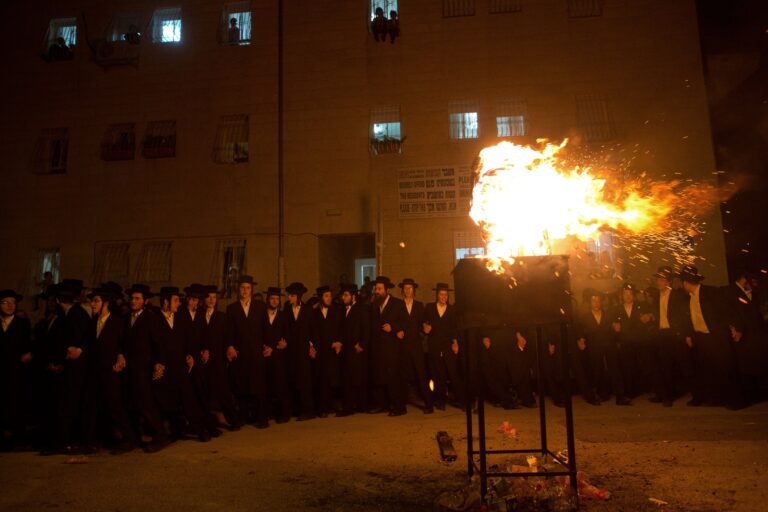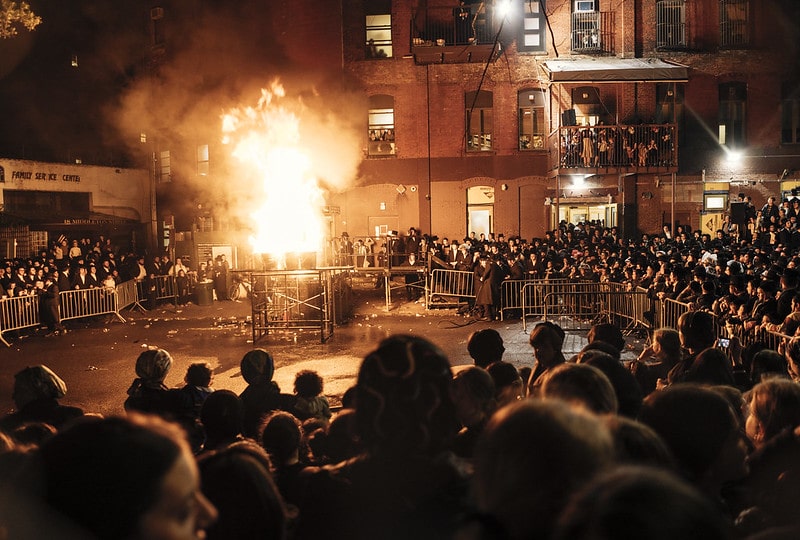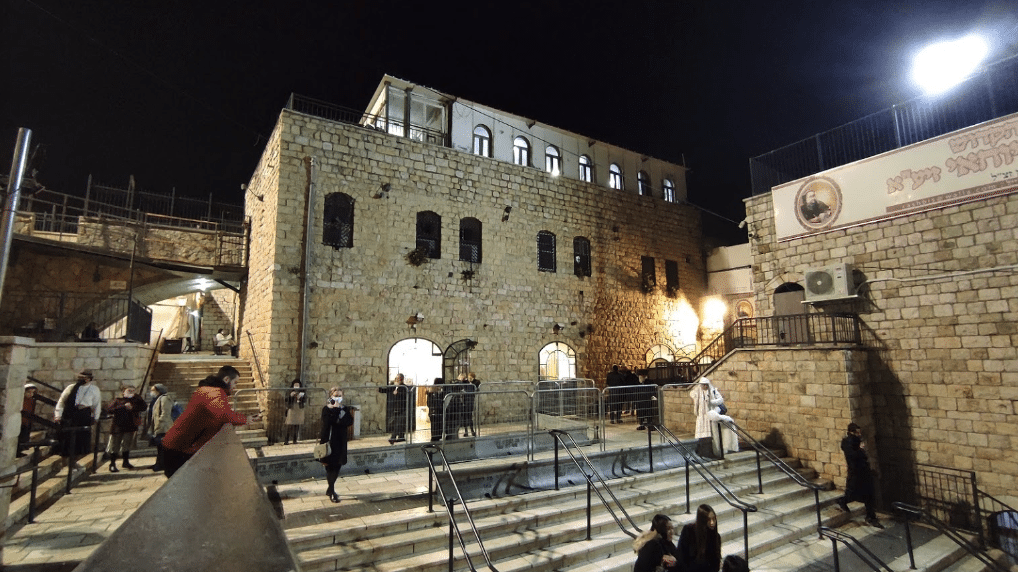
Lag BaOmer occurs on the 33rd day of the Omer, which is the 49-day period between Passover and Shavuot. The word “Lag” represents the number 33 in Hebrew, and the name “Omer” refers to the Biblical “omer,” a unit of measure. Here’s everything you need to know about the holiday.
Read more: Get our guides to all the Jewish holidays.
When is Lag BaOmer 2024?
Lag BaOmer starts the evening of Saturday, May 25, 2024, and ends in the evening of Sunday, May 26, 2024.

What is Lag BaOmer?
The Omer period is a time of sadness, during which weddings, parties, live music, dancing and getting haircuts are generally forbidden (read more about this below). Lag BaOmer is a break in this period of sadness — it is a happy occasion when the mourning practices are lifted.
According to Kabbalistic tradition, the day also marks the anniversary of the death of the great second-century sage Rabbi Shimon Bar Yochai (also known as the Rashbi). Some Jews also attribute Shimon Bar Yochai with the authorship of the Zohar, the foundational text of Kabbalah (mystical Judaism).
Key features of Lag BaOmer include Jewish weddings and getting haircuts. In Israel, many celebrate by lighting bonfires and having barbecues to symbolize the light that Shimon Bar Yochai brought into the world.
Each year on this day, to celebrate his legacy, hundreds of thousands of Jews from all over the world visit his tomb in the northern Israeli town of Meron for singing, dancing and merrymaking.
In 2021, this turned out to be a horrific nightmare. In the worst peacetime disaster in Israel’s history, 45 people were killed and at least 150 people were injured when a stampede broke out at the celebration. This year, the Israeli government approved new safety regulations to ensure this does not happen again.
What is the Omer and why do we count the days?
The Torah (Vayikra / Leviticus 23: 15-16) commands us to count each day of the Omer. Each night, from the second night of Passover until the day before Shavuot, we recite a prayer stating what day of the Omer it is in days and weeks. For example, on the 18th day, one would say: “Today is the 18th day, which is two weeks and four days of the Omer.”
Counting the omer reminds us of the link between Passover (celebrating the Jewish people’s miraculous exodus from Egypt) and Shavuot (commemorating the giving of the Torah on Mount Sinai). We are reminded that Passover started the process of redemption, but that it was not complete until we received the Torah.
According to the Talmud (Yevamot 62b), this period is generally a time of sadness because — approximately two thousand years ago — twenty-four thousand of Rabbi Akiva’s students (twelve thousand pairs of hevruta, Torah study partners) died of a plague between Passover and Shavuot.
The rabbis (in Yevamot 62b) explain that Rabbi Akiva’s students died during this time “because they did not treat each other with respect.” Meanwhile, historians connect this calamity with Simon Bar Kochba’s revolt against the Romans (in 132 – 136 CE).
Rabbi Akiva was a fervent supporter of the Bar Kochba rebellion and thousands of his students were part of the rebel forces. Despite its initial successes, Bar Kochba’s army was ultimately defeated and many of Rabbi Akiva’s students were killed in the fighting.
According to Jewish tradition, the “plague” ceased on the 33rd day of the Omer (which falls on the 18th of the Hebrew month of Iyar). This may have been a day when there was a momentary victory in the battle, or a respite from the fighting. As a result, Lag BaOmer became a happy occasion when the mourning practices of the Omer period are lifted.
There are different opinions about when the period of mourning during the Omer begins and ends. Although some observe mourning (i.e., do not participate in joyful events) from Passover until Shavuot except for Lag BaOmer, many others observe mourning only until Lag BaOmer (Shulchan Arukh, Orach Hayim 493:1 in Rema).
What is it like to celebrate Lag BaOmer in Meron?
In 2004, our executive vice president Noam Weissman traveled to Meron to celebrate Lag BaOmer. We asked Noam what this experience was like, and here’s what he told us:
In 2004 on Lag Baomer, my friends from yeshiva and I spent a weekend in Meron. We joined hundreds of thousands of Jews who gathered together for camping, praying, singing and celebrating.
They were from all walks of life: Hasidic and non-Hasidic Jews, free-spirited and Phish Heads and more Haredi and traditional, Jews from Israel, the U.S., South Africa and around the world. Despite our different backgrounds, all of us had come together to celebrate Jewish spirituality and the mysticism Rabbi Shimon Bar Yochai helped reveal to the world.
I remember the sheer magnitude of people who had gathered in one small space and the dramatic effect this had on me. In the sea of people, it almost felt like my feet were levitating. I felt like I was brought to a different place spiritually. I still bring to mind the powerful atmosphere I experienced at Meron to charge me every now and then, and know that millions of other people have experienced the same thing.
Even though I didn’t know anyone who attended Meron last year personally, and live thousands of miles away in South Florida, I felt and still feel devastated by this tragedy and the loss of 45 Jewish lives. The fact that Lag BaOmer marks the end of a plague from two thousand years ago that killed Rabbi Aviva’s students and is meant to be the ultimate celebratory day, makes this disaster even more painful for many of us.
This year’s celebration is undoubtedly not the same as we remember those who lost their lives in this terrible disaster. I am glad that new security measures are in place this year and that Jews from different backgrounds and all over the world will once again come together for this transformative experience.
Rabbi Shimon Bar Yochai’s Ideas

In honor of Lag BaOmer, below is a famous story about Rabbi Shimon bar Yochai, plus three powerful ideas that are attributed to him.
- The story of Rabbi Shimon Bar Yochai leaving the cave:
The Talmud (Shabbat 33b) tells the story of Rabbi Shimon bar Yochai and his son, Rabbi Elazar, leaving the cave where they had been hiding for 12 years. The story goes like this: Rabbi Shimon bar Yochai spoke critically of the Roman government, which was reported to the authorities.
The Romans sentenced Rabbi Shimon bar Yochai to death, so he and his son went into hiding in a cave where they spent each day doing nothing but studying and praying. They were miraculously sustained by a spring of water and a carob tree that had appeared in the cave. Twelve years later, the Roman emperor died and their death sentence was lifted. But when they left the cave and reentered the world, something surprising happened. Watch this video from our friends at Aleph Beta to hear the rest of the story:
- “Anyone who helps a fellow Jew is considered as if he helped God himself.” (Midrash Tanchuma, Vayechi 5)
Rabbi Shimon Bar Yochai was a strong proponent of ahavat Yisrael, loving the Jewish people. Rabbi David Wolpe expanded on this: “Loving and embracing your people of origin is not to hate or look down on others; it is an affirmation made daily by members of almost every group, religious, ethnic, cultural and national.” - “There are three crowns: the crown of Torah, the crown of priesthood, and the crown of royalty, but the crown of a good name (shem tov) supersedes them all.” (Pirkei Avot 4:13)
Although Rabbi Shimon bar Yochai recognized Torah study and prayer as essential components of Judaism, he believed that these activities are not enough by themselves and that they must be translated into good deeds. - “It is better for a person to make himself fall into a fiery furnace than to embarrass his friend in public.” (Sotah 10b)
Rabbi Shimon bar Yochai taught that humiliating others in public causes great pain and shame. He reminded us to always be sensitive to others’ feelings and spare them embarrassment, one of the most important principles in Jewish tradition.
Originally Published May 8, 2023 11:47AM EDT
